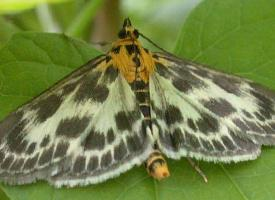
Váhy a míry
| Délka rozpětí křídel | od 16 do 20 mm |
|---|
Popis zvířete
The Indianmeal moth, scientifically known as Plodia interpunctella, is a small but significant pest commonly found infesting stored food products. This species is particularly notorious for its ability to thrive in a variety of environments and its preference for a wide range of dry, stored food materials, making it a widespread issue in both residential pantries and commercial food storage facilities.Adult Indianmeal moths exhibit a distinctive wing pattern that serves as their most recognizable feature. Their forewings are uniquely colored, with the basal half displaying a yellowish-gray tone and the outer half a reddish-brown with a dark band at the intersection of these two colors. This striking coloration not only aids in their identification but also adds to their visibility when they flutter around infested areas. The wingspan of an adult moth typically ranges between 16 to 20 millimeters, allowing them to navigate through small openings into food storage areas.
The life cycle of the Indianmeal moth is composed of four stages: egg, larva, pupa, and adult. Females lay their eggs directly on or near potential food sources, ensuring that the emerging larvae have immediate access to nourishment. These eggs are extremely small and whitish in color, making them difficult to detect with the naked eye.
Upon hatching, the larvae are white or pinkish caterpillars with brown heads, capable of causing considerable damage to stored food products. They feed voraciously on a variety of items, including grains, nuts, chocolates, beans, dried fruits, pet food, and birdseed, among others. Their feeding not only results in the direct loss of food but also contaminates it with their silk webbing, frass (waste), and shed skins, rendering the food unfit for consumption.
After reaching maturity, the larvae seek a secure spot to spin their cocoon and enter the pupal stage. This stage is relatively brief, but the location chosen for pupation can be anywhere within the infested area, including walls, ceilings, or even within the food product itself.
The adult moth emerges from the pupa to continue the cycle, living only long enough to mate and lay eggs. The entire life cycle can be completed in as little as 25 to 30 days under optimal conditions, allowing populations to increase rapidly and infestations to spread quickly.
Control and prevention of Indianmeal moth infestations primarily involve good hygiene and storage practices. This includes regular cleaning of storage areas, using airtight containers for food storage, and discarding infested products. In cases of severe infestation, chemical control methods or professional pest control services may be necessary to eliminate the problem.
In summary, the Indianmeal moth is a resilient and adaptable pest that poses significant challenges to food storage. Its ability to feed on a wide range of dry stored food products, coupled with a rapid life cycle, makes it a formidable pest. Effective management relies on a combination of good sanitation practices, vigilant monitoring, and, when necessary, targeted pest control measures.
Podobná zvířata
Nové fotografie zvířat
Top 10 zvířat
- Dolphin gull (Leucophaeus scoresbii)
- Diana monkey (Cercopithecus diana)
- Moustached guenon (Cercopithecus cephus)
- Galápagos tortoise (Geochelone nigra complex)
- Russian tortoise (Testudo horsfieldii)
- Japanese macaque (Macaca fuscata)
- Stone loach (Barbatula barbatula)
- Greek tortoise (Testudo graeca)
- Common flying dragon (Draco volans)
- Colossal squid (Mesonychoteuthis hamiltoni)


